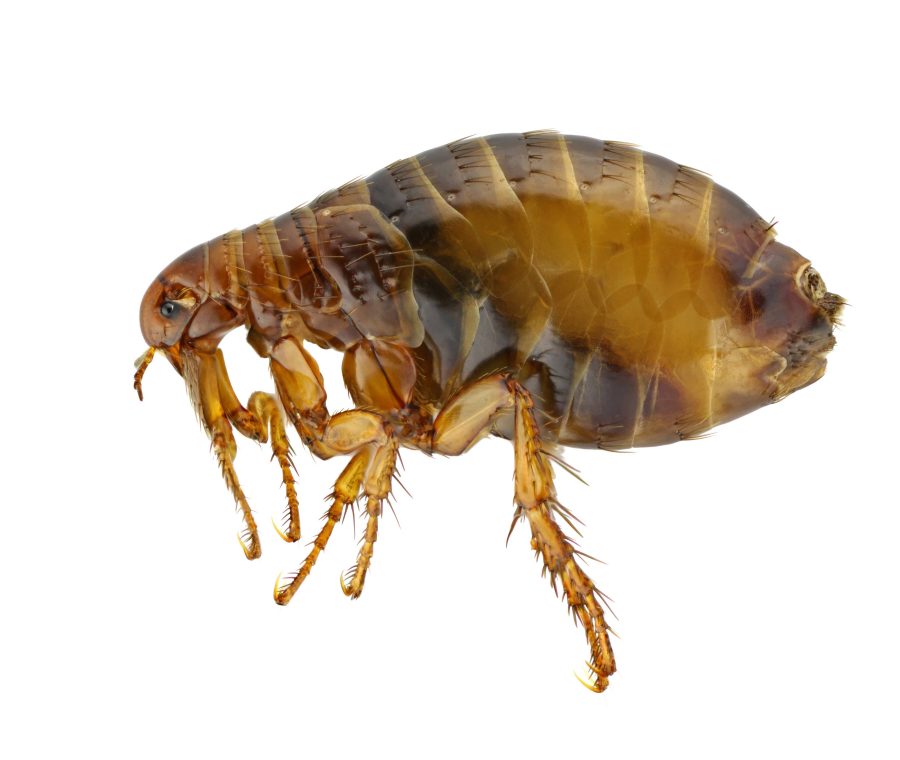As soon as spring arrives, fleas take advantage of the warmer weather to colonize the fur of our dogs and cats. Constant scratching, allergic reactions, risk of disease transmission – despite their size, these little creatures can seriously complicate the lives of both your pet and you. So, be cautious! With the arrival of sunny days, a few precautions are necessary to protect our beloved four-legged companions.
What is a flea?
Fleas are brown parasites measuring between 2 to 6 mm as adults. To survive, they inhabit a host (a dog or a cat, for example) and feed on its blood. After digesting the blood, they leave behind black excrement, a characteristic sign of their presence.
Keep in mind that fleas lay up to 50 eggs per day, and the vast majority of them fall into the environment. Consequently, in case of infestation, there are more fleas in a house than on the animal’s back!

How does my pet catch fleas?
Contrary to common belief, a cat or a dog rarely catches fleas by coming into contact with an infested animal. In fact, fleas are present 95% of the time in the environment (carpets, sofas, cushions, cars, etc.). Therefore, by settling in a contaminated area, fleas take advantage to infest your pet’s coat.
What are the symptoms of a flea infestation?
An infested dog or cat might:
- Show no symptoms;
- Scratch or nibble itself. The preferred areas are the lower back and belly;
- Lose its fur, a sign of flea bite allergy (Flea Allergy Dermatitis). These depilations occur mainly on the lower back and back thighs for dogs, and on the neck and back for cats.
How can I tell if my dog or cat has fleas?
A highly effective method to determine if your pet has fleas is to comb it with a flea comb (a comb with tightly spaced teeth) and collect any debris on a tissue or compress. Then, add a few drops of water.
If the debris or flea droppings turn red, bad news: your pet has fleas!
But, beware! Regular licking and nibbling allow your pet to eliminate the fleas itself. So, it’s possible not to find fleas during grooming.

What are the risks for my dog or cat?
There are 3 major risks:
- Formation of infected wounds. Constant scratching can injure your pet’s skin. If these wounds aren’t treated, they can become infected.
- Allergy to flea bites (Flea Allergy Dermatitis – FAD). When a flea feeds on an animal’s blood, it also injects an anticoagulant. This substance triggers allergic reactions in some animals.
- Disease transmission. While grooming or nibbling, your pet swallows fleas. Some of these fleas contain eggs of digestive worms, called “tapeworms.” While these worms cause only mild digestive disturbances in most dogs and cats, they can have much more serious consequences in fragile animals.
How to prevent and cure a flea infestation?
Numerous products exist to combat fleas.
Spot-On or Pipettes
For your pet, you can use spot-on treatments by following a few precautions. It’s important to part the fur (creating 3 to 4 rows) to directly apply the product onto the skin and in areas inaccessible to the animal to prevent licking and ingestion. If the product is applied to the fur and not the skin, it won’t spread and will have limited effectiveness.
Sprays and Foggers
If your dog or cat has fleas, it’s likely your home has even more. Treating the environment is crucial to eliminate them. For this purpose, sprays and foggers are particularly effective.
Flea Collars
Flea collars have a preventive action against fleas, but do not allow for treating an infestation. Additionally, they must be positioned in direct contact with the animal’s skin for the insecticide to spread over the entire coat.
However, make sure that the collar is equipped with an anti-strangulation system to prevent any accidents.
Shampoos, powders, and lotions
These products can kill fleas, but they have no short-term or long-term effect. Therefore, they should be supplemented with another type of product like pipettes or spot-on treatments.
You may also be interested in this article: What foods are toxic for dogs?
